A few months ago I did a piece entitled 'Canada and the Support Ship' that looked at potential options to supplement the current two Joint Support Ships entering service. It was fun to do, and from a time when I had under 100 subscribers, so if you haven't checked it out yet, go have some fun.
TL;DR The best option would be to procure more JSS as part of a second batch, so long as it doesn't interfere with the Multi-Purpose Icebreaker schedule. Seaspan these days is fairly confident it could achieve that, at least in my few conversations with them.
One thing I neglected to fully discuss during that piece, and one that always comes back to me time and time again, is the Global Logistics, Aviation, Amphibious, Medical Support Platform from Davies, aka GLAAM.
This is quite funny, as I have had somewhat of a monopoly on the GLAAM subject, which is probably why it keeps coming back to me. I think I'm one of the few who ever brings it up, and probably the one who does most frequently.
Maybe that's why it always surprises people when I don’t throw my support behind it. In fact, historically, like most larger vessel proposals, I have been fairly unsupportive of talks of acquisition. As I stated in my Support Ship post, I believe priorities are needed elsewhere, on getting more important things done, and given the River-class, subs, and CDC are a decade out, there is little pressing need for anything beyond the two JSS in the immediate term.
At least not to the point of urgency. I would rather see CPSP fully funded along with CDC before any talks of new vessels like GLAAM. I have always made that clear. That remains my overall position now.
However, in the last few months, I've been surprised to see just how much universal support the proposal has, both from the average online reader and those in the navy. There is a fairly broad love for GLAAM, even among those who would rather have JSS—there is always some love to be thrown its way, even as an 'if only x and x allowed it' conversation piece.
And let it be known, I don't dislike GLAAM at all. I think it's cool. I think it's unique and has capabilities I like. Even if it didn’t make it into my initial assessment, I focused on vessels a lot smaller like the Vard 7 313, that doesn’t mean we can't acknowledge GLAAM and its potential.
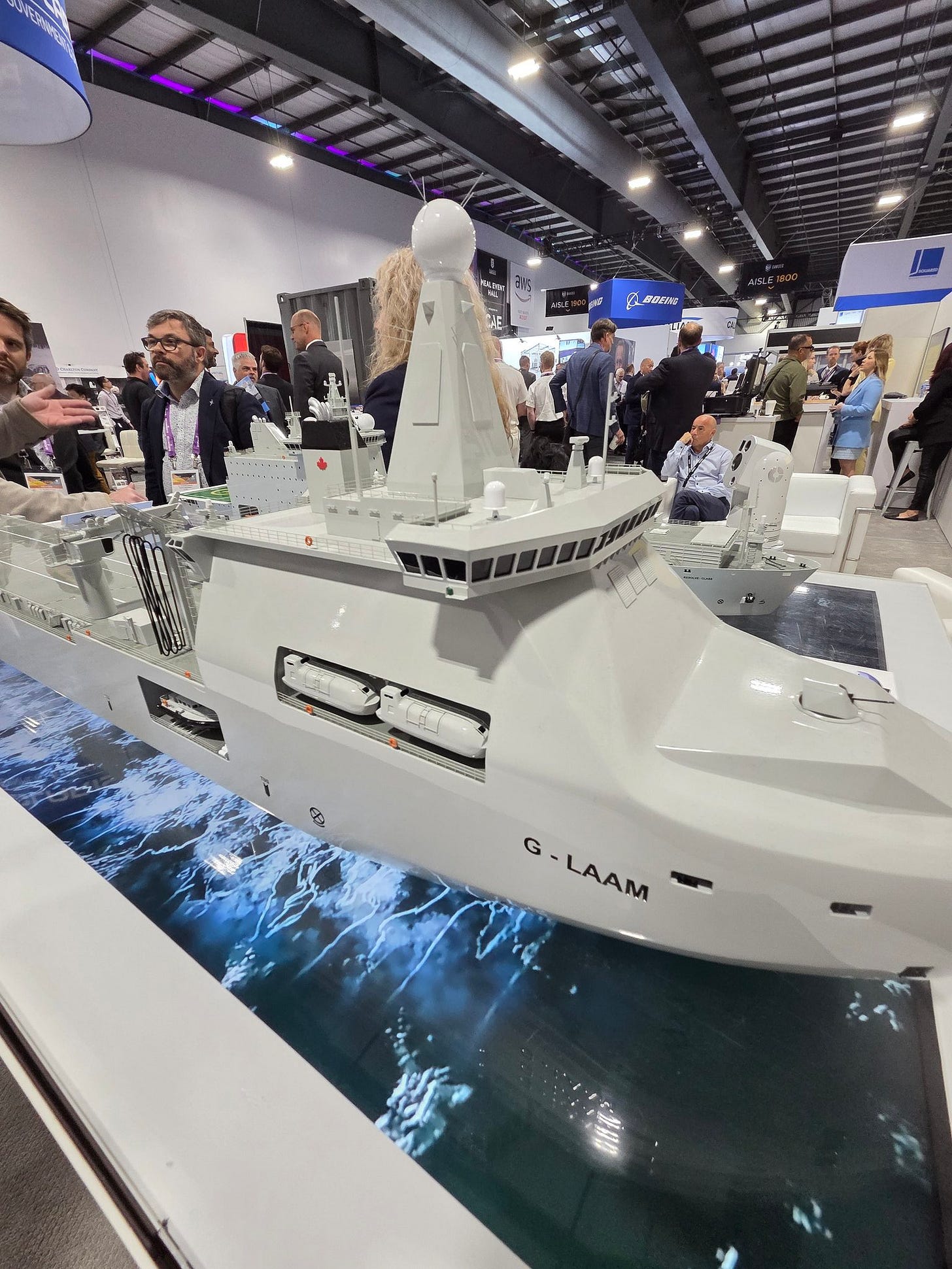
So. What is GLAAM?
First, what is GLAAM? For those unaware, GLAAM is a proposal from Davies Shipyard for, essentially, a Multi-Functional Support Ship. One could even call it a Joint Support Ship! In fact, looking at GLAAM you can see a lot of what was originally demanded from the Joint Support Ship in its first proposals with the Afloat Logistics Support Capability (ALSC).
Of course, ALSC would evolve into the JSS project and over time drop the amphibious, RO/RO, and vast majority of HADR capabilities. Of course, that's another conversation for another day, but a lot of GLAAM, at least to me, reminds me of that concept—and then some.
Visually and capability-wise, she is very similar to the HNLMS Karel Doorman. In fact, you could almost call them sisters. They share many design features and capabilities that take a step above the traditional Landing Platform Dock we see in other navies.
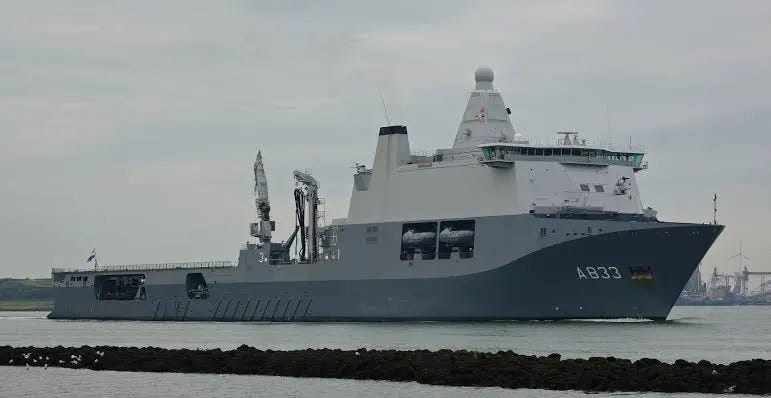
Compared to the Karel Doorman, GLAAM is slightly smaller at 180–190m long. While I have never asked for a proper tonnage, it's likely to be ~30,000 tons. This depends a lot on what Ice Class you would be discussing, as that could add quite substantially.
It's probably one of the main attractive features to a country like Canada, but fun fact: GLAAM comes both ice-strengthened according to the Finnish-Swedish Ice Classification system, up to an IACS Polar Class III depending on the demands of the customer. Most commonly you'll see her referred to as a Polar Class IV vessel.
I should note as well that the higher Polar Class means sacrificing some internal space. I also have not gotten detailed numbers as of this time about the internal space. GLAAM features a Well Deck as well as a Ro/Ro Tweendeck. Davie advertises it as 'medium-sized,' but I believe it's ~1500-2000 lane meters similar, though likely a bit less than Karel Doorman given her slightly smaller size. She also has space for a 12m RHIB.
This is undoubtedly the feature that gets many going. Anytime you mention amphibious capabilities, people get a bit giddy. However, I find it a disservice to the platform to focus primarily on that capability, especially since, to me, the platform offers a lot more value in other areas.
For example, GLAAM also has a solid/liquid replenishment at sea capability, NATO Role III hospital that includes operating facilities, a dedicated storage area for HADR supplies, and a container storage section modeled after MV Asterix's rapidly deployable container bays, allowing GLAAM to rapidly load and unload 20ft standard containers.
GLAAM also has an AHC crane to support in forward ship repair and submarine support operations. This is helped by GLAAM having, I believe, a Class III Dynamic Positioning system. As far as I know, there is no dedicated space or equipment for submarine support outlined in GLAAM.
That might be something that can be added on an emergency basis. I wouldn't want a vessel like GLAAM doing submarine support any more than any other vessel. That might sound harsh, and it's nice to have this capability in an emergency, but submarine support requires a dedicated vessel with the integrated support systems and capabilities thought ahead of time.
That's just me. It's not a task I would want put on an ad-hoc way. I've said similar with the AOPS, but it is nice to have a vessel able to do these things in an emergency, and lacking a vessel elsewhere, you need to make do with what you potentially have. We'll discuss that after though.
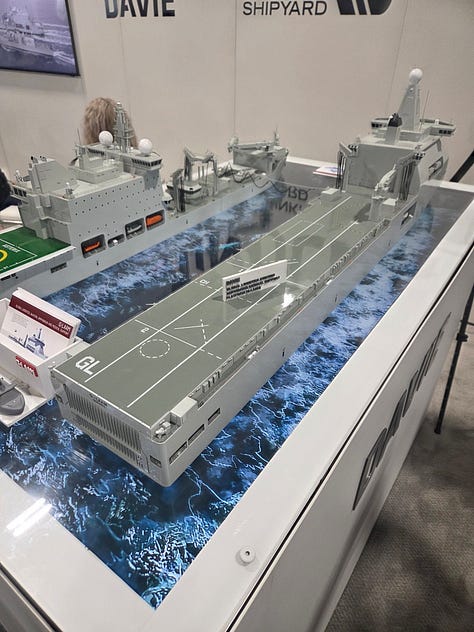
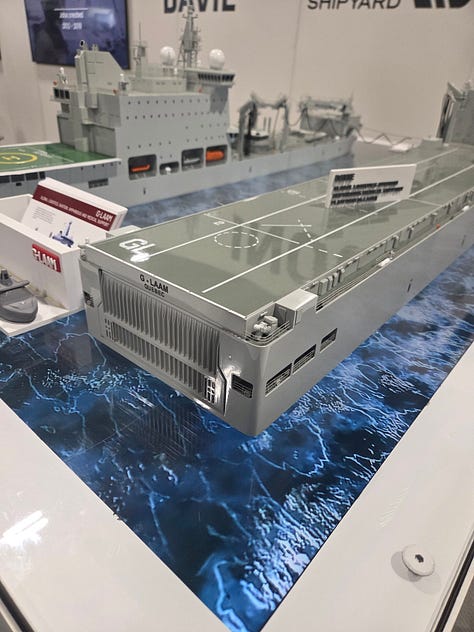

GLAAM's flight deck has the capacity to support up to five Chinook-sized helicopters. It has a dedicated hangar and workshop facilities accessible by elevator. This large flight deck does provide a lot of space and opportunity as well for unmanned systems, something Davie has been showing off more in material related to GLAAM.
GLAAM, as presented, is armed with a Bofors 57mm main gun, as similarly found on the Halifax-class. Self-protection is provided by, as I counted, four RIM-116 SEARAM launchers, two mounted on the aft quarters just abaft the flight deck, and two mounted on either side of the ship's funnel.
For a ship of her class, this is fairly well armed, although I would have liked to see something like a 30mm Lionfish or two added to provide some lower-end CUAS/small craft protection. That is minor though.
You get a good idea of GLAAM. There is a lot to her. Similar to Karel, she is a do-everything vessel, and that is both her biggest strength and the thing that is holding her back.
The weaknesses
I don't want to use the term weaknesses here because inherently there is nothing wrong with certain things here. Really, there is one big, glaring nail sticking up for me to hammer down on. You already know what it is.
The Well Deck... the whole amphibious capability in general. It's one of the main features of GLAAM, and also one that makes it hard to throw a wide endorsement. It's also one of the major things that separates it from something like the JSS when we stack them together.
I don't think I have to go into why an amphibious capability isn't our alley. We've historically never had a need for it. We aren't expecting to be taking part in any wide-scale amphibious operations, and there's little desire to spend money and resources to acquire such a capability when our allies would rather we focus on areas of strength.
It requires an all-of-CAF approach beyond just the navy, and the army has been clear such a shift isn't in their books or planning. That's been said as recently as this year when Brigadier-General Stephane Masson spoke to Canadian Army Today about modernization.
It's an expensive, large capability that will take years to prepare and build a force for, and for questionable reasons considering that plenty of our allies already have this capability and it's questionable just how many, if any, contested landings the Canadian Army will be expected to partake in.
In a military already lacking in manpower, with critical deficits and a hundred other projects on the table, is now the time to be talking about building an amphibious capability that will take ten, fifteen-plus years to deliver?
But Noah, the Arctic!
Yes, the Arctic. If you reach the point where you have to land an amphibious force up in the Arctic Archipelago, for any reason other than something having gone awfully, terribly wrong, we have bigger issues on our hands.
There will be no grand ground battle in the Arctic. I'm sorry to say it that way. Not only is it suicidal to any occupying force, it's completely illogical to waste such resources to occupy space enough to justify bringing a whole GLAAM up to the Archipelago.
So to the people who have presented me that idea, I'm sorry, but I'm not convinced.
Okay, but the Ro/Ro capability?
This one makes a bit more sense. However, it comes back again to the cost-benefit of GLAAM basically being a glorified Ro/Ro vessel to run things to Latvia and maybe up to the Arctic for things like Nanook, maybe. This is a role it can do, certainly, but is it worth the cost of GLAAM to have that capability versus, say, something like the Point-class?
You can buy civilian-constructed or minimally militarized Ro/Ro vessels for a lot cheaper and get 90% of the same effect, especially if you're just running to Latvia and back. To that degree, I agree that we should have a sovereign Sealift Capability. These kinds of services have a long lead time and are limited. They aren't readily available if needed quickly.
But is GLAAM that vessel? Is it worth it to push everything onto this one vessel as opposed to, say, more JSS and a few cheap Ro/Ro that could either be used for other roles, or even rented out by the federal government when not in immediate need?
There's a lot of potential there. That is, of course, up to the imaginative powers of those in power to come up with such things, but these options do exist. Extra Ro/Ro capability domestically is an asset in itself. However, that does require a separate Ro/Ro class to be made and be available, easier than GLAAM, but still something that would likely not win much care from those outside our community.
Its something GLAAM can do, but is it something that we want it to do? Is it worth that extra capability? That's where GLAAM wins in any debate.
The Strengths
I wanted to get the weaknesses out of the way first, because I think it sets GLAAM up to better show off the strengths that it does have and how they can tip a seemingly impossible scale. To start, the Ro/Ro capability and that space still exist.
While we've been talking about it in terms of amphibious capabilities, that extra space is free to do a number of other tasks, be that carrying more HADR stores, being used as makeshift space to accommodate more people, supporting allies in the event that they need that extra capacity, think of the current situation affecting the Royal Navy or RFA, or even being used as an unmanned mothership, using the Well Deck to operate larger USV or XLUUV.
That space is still space. It does not disappear, and while none of these will set it up to mitigate the lack of need for its traditional use, that doesn't mean there is no value that can be extracted from it. It is as you make of it. You might have heard me say something similar of the River-class Mission Bay. You are limited by what you can think of to use that area for.
GLAAM also still maintains an extensive HADR capability, something that many commentators will miss, but a role that everyone I've met in the navy takes quite seriously and proudly.
GLAAM is a HADR wonder, with extensive aviation facilities, a large hospital perfectly set for independently supporting disaster zones, dedicated HADR storage specifically designed to not compromise other capabilities, and the ability to rapidly load and unload containers, such as containerized medical facilities. GLAAM always had a big HADR focus in mind and the design shows it off at every chance it gets.
For a country like Canada that prides itself on its international efforts to support humanitarian missions, as well as a country that has in recent years dealt with several of her own disasters that left our coastal communities ravaged, it’s understandable that such a capability is top of mind.
That isn’t including its Polar Class rating, which allows GLAAM to operate independently in the Arctic. This is another point that applies to everything here: HADR included.
While expanding the Coast Guard fleet with more numerous, more capable vessels will help in expanding the Canadian government's reach, none of these would have the capabilities that GLAAM would offer. This is one that’s been brought up to me numerous times on the naval side of things.
As climate change continues to change the face of the Arctic, not only will communities have to deal with crumbling infrastructure networks, such as the ever-collapsing ice road network and the effects of permafrost melt, but they will also have to deal with a local environment that is rapidly changing before their eyes.
When the ice starts to melt it doesn't just go away. It shifts, it drifts, it blocks passages, destroys traditional paths of fishing and hunting. The shifting ice brings the community with it through its changes. We already see parts of this, where multi-year ice shifts west across the Archipelago as thinner, first-year ice fades away. This buildup of ice blocks vital passageways across the Northwest Passage and makes navigating the already minimally charted Arctic even more dangerous.
This opens up avenues for new disasters, especially as this same melting ice presents easier access to the Northwest Passage. While I am not the Northwest Passage’s biggest advocate, nor do I believe it will be as major an international route as others, there still is a future where increased traffic steadily rises over the coming years.
Combined with shifting climates forcing communities to adapt to this ever-changing world, those who take the risks in exploring outside the limitedly charted paths of the Archipelago (which themselves are at risk thanks to that same shifting climate), either in search of economic gain or pleasure, and increased traffic of potentially dangerous goods, especially with those who believe we could move oil through the Arctic, as mad as that is, you have a recipe for a future of humanitarian disasters.
That’s why the HADR side of GLAAM is so appealing. It isn’t born out of merely a desire to support efforts overseas but a careful question on if we are prepared for a potential humanitarian disaster in the Arctic, and whether we need to be prepared to tackle those challenges in the future because the possibilities are there, and they can't easily be ignored.
And that does apply to everything else. Take the replenishment at sea or forward ship repair capabilities. GLAAM would give Canada the only Arctic-capable vessel able to undertake those tasks. If you want to operate more consistently up North, you need the ability to support it. No hate to Nanisivik, but like no.
So something like GLAAM, able to support other vessels up in the Arctic, is a very tempting proposition for a country that lacks the facilities to match it, and will likely struggle to build that kind of shore-based support infrastructure. This is by no means a superior alternative but it is a potential solution to an issue we have struggled to put a dent into.
Even outside the Arctic, GLAAM is still a supplement to the JSS. It can still move people and equipment in a Ro/Ro capacity. They are still highly capable vessels able to support other operations globally, be that supporting ASW operations in the Atlantic, taking part in humanitarian operations abroad, or providing support to our NATO and Arctic partners.
Support for more icebreakers is there
Another point to raise deals with a more political side of things. During the federal election, the Conservative Party proposed adding two additional Polar-class icebreakers to the Royal Canadian Navy, doubling the fleet from the two expected for the Canadian Coast Guard.
Similarly, from talking around a bit, the Liberals have also been open to the idea of more icebreakers, but don't seem to have gotten as far as to support the idea in a government capacity. However, the door seems to remain open for it in the future.
This gives some window of opportunity to the concept, where the possibility for new Polar-class icebreakers meets with the potential to supplement the JSS, of which we all know two is far too little for our needs. That is a very real possibility in the event the government, or a future one, pushes for a Navy Polar capability.
Already running two different designs for our current Polars, I won't be one to question a potentially third, especially if fundamentally that design is different from the other two, which GLAAM would be. Yes, you won’t get a similar Polar Class II vessel, but that sacrifice to me would be worth the capability it would hypothetically provide.
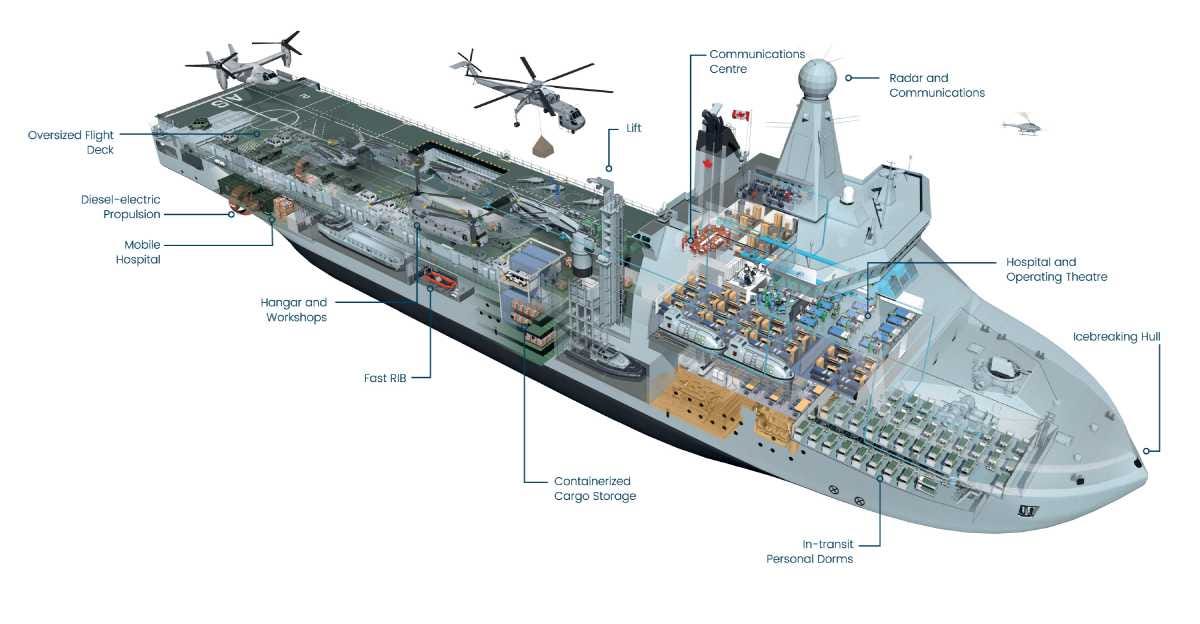
So. What about GLAAM?
I stand by the solution that the need for more replenishment vessels is more JSS. That is the simple, effective route that gives us what we want. I also support acquiring a fleet of Ro/Ro vessels to give Canada a sovereign Sealift capability.
However, that doesn't mean that I am against GLAAM. Far from it. I get why it's so popular. I get why navy brass love the design and concept. I get the value that it does bring, and it does bring a lot of value on paper.
Still capable of RAS, with an extensive HADR capability and a forward/submarine support capability. It still provides a Ro/Ro capability, along with well access for any number of purposes. It has substantial aviation capability. All of this in a vessel that also comes with a Polar Class IV rating, if not higher if desired.
That Arctic capability can't be undersold. It makes the vessel not only unique for us but, for an alliance that wants to take a greater role in the Arctic, gives us a platform unique for NATO, that could operate in conjunction with other Arctic allies like the Nordics or the UK, who also maintain a stake in the GIUK-Norway gap.
So for me, it gets a bit difficult because it is very hard to ignore what it brings, and that is a lot. It will take effort. It would take years to even build the aviation fleet to use a vessel like this to its full advantage, let alone the amphibious capabilities.
But to raise another point, and yes it would be a risk, perhaps we've already started, and perhaps a vessel like GLAAM is the push we need to straighten some things out. It isn’t a platform we could handle now, yes, but with the navy exploring a range of unmanned systems, and NTACS starting to get into full swing, there is a unique chance to have these kinds of conversations.
Stars aligning and what have you, where other projects come together to kind of push the conversation a bit more to the forefront, as opposed to mere dismissal. GLAAM, to me, does a very good job at that, asking these questions of why, what, and how. It pushes this envelope at a time when we are asking, as a country, what we want to be.
Do we want to be more out there? Do we want to be an independent player? Do we want to have that active role where a vessel like GLAAM becomes a necessity? These are questions that we're asking now, as we get set for restructuring in September and a new foreign policy, hopefully, soon.
Both of which tie well to this conversation in my mind. It isn’t necessarily a yes-or-no question here. I can't say yes or no on GLAAM, or something similar in the future. I think GLAAM would be an amazing asset to have, highly capable and impressively packed. Davies did a good job on this one. I give them credit. I like GLAAM. I like it a lot, and I know many feel the same way that I do. It's a conflict, where you have to acknowledge the weaknesses, but man, there’s a lot in there that sounds really nice.
So, why not GLAAM? Because there are still conversations to be had on what we want to do and who we want to be. That isn’t a no. It just means we need to establish what our goals are, what our foreign policy is, before we can make a judgment on what kind of navy we need.
This goes the same for something like CPSP or CDC. Do we want to be a global player, or do we want to be a part of the team? Certainly, you look at plans and get the feeling we want to be more, if you all remember my piece on deterrence. Yet the policy, the government side of things, isn’t there yet.
That could change. A part of me hopes it does deep down, I won't lie to everyone there. I want to see us do more, be more involved, to play a bigger role in the conversation. We won't ever be independent in our foreign policy, that’s a given, and the idea that we can is not set in reality.
However, we can raise ourselves up to be a major player at the table, up there with our European allies like France and the UK. That requires a lot, as I’ve spoken before, and maybe GLAAM has a role to play there. I think it could.
I think it's unique enough from the JSS to be its own thing, although that is more hopeful on my end. I think it would be fine as a complement, and few would complain if it came down to that. I have made it known I lean JSS, but I wouldn't fight GLAAM if it came to pass.
I just hope that we figure it out sooner rather than later.




Two points to add to the pot in regards to HNLMS Karel Doorman. First, after commissioning her, the Dutch ended up ordering a more conventional AOR (Den Helder). Two, the Dutch will be replacing their two LPD older sisters of the Doorman (and four Holland class OPVs) with smaller vessels (~10-12K ton range). Food for thought.
While a propper amphibious capability is outside of our list of wants, I do think the ability to do strategic sealift to areas that are lacking port infrastructure would be beneficial. We don't need to work on developing a capibility to do opposed landings from the GLAAM. But how about getting equipment and vehicles onto Victoria Island (or any other island in the archapeligo)?
I didn't view the well deck and amphib capability as "lets train for Pacific Island hopping". I saw it as a reflection of the lack of port infrastructure in the arctic and giving the CAF the ability to move the DAME vehicles in quantities that airlift can't match to wherever we want to run exercises and show a presence.
Unless the Ro/Ro capabilty can be used without a propper port (my experiece with Ro/Ro is limited to BC Ferries haha). Then that whole point is moot.